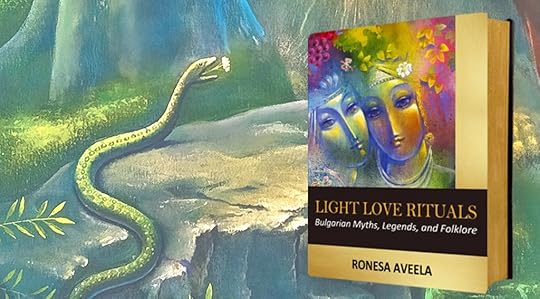Ronesa Aveela's Blog, page 2
April 16, 2025
Chasing Evils and Breaking Curses
Spring: A Time for Rebirth and Rituals in Bulgarian Folklore
Spring is a season of rebirth, when nature awakens from its long winter slumber and bursts into life with color and energy. In Bulgaria, this season is not just a shift in the weather; it’s a time deeply embedded in culture, folklore, and rituals. Each day brings with it the opportunity to connect with nature and celebrate the renewal of life.
When March comes, I know that spring is on its way and the light in our lives will return. In this transforming time, we need positive energy to embrace the change. The season gives us new hope and energy, and we dust ourselves off and feel more energetic and ready to achieve our goals.
I love to work in the yard, relaxing and thinking of new ideas for our books or creating new paintings. I haven’t painted so far this year because we are busy with our new book series.

Flowers from my garden
Baba Marta DayOne of the first symbols of this seasonal shift occurs on March 1, when Bulgarians celebrate Baba Marta Day. On this day, people wear a martenitsa, a red-and-white amulet, symbolizing the return of spring and the melting of snow. It’s not only a mark of the changing season but also a symbol of health, prosperity, and friendship.
I love to make martentsi each year, not only for my family and friends but also for our pets.

My daughter’s labradoodle, Ronnie, with a homemade Pijo & Penda martenitsa. He also makes an appearance in book 1 of our new series.
A Bulgarian martenitsa is exchanged as an amulet between friends a loved ones, a gesture of goodwill, wishing the wearer happiness and strength for the year ahead. As snow melts and flowers begin to bloom, so does the spirit of camaraderie and renewal among the people. I love to wear the charm as a bracelet, but there are many designs. We have some ideas and projects included in our book Light Love Rituals: Bulgarian Myths, Legends and Folklore if you want to learn more. Also people use martenitsi to predict their future.
International Women’s DayAlso we have one very important day: March 8.
In Europe this is the equivalent of Mother’s Day. In Italy they wear yellow mimosas, while in Bulgaria I gave my mom snowdrops or roses and a homemade card. It was special day to celebrate not only mothers but womanhood.
This is why March 8 is another significant date in the Bulgarian calendar, International Women’s Day. On this day social media is covered with virtual roses. It is a day to honor women, those who tirelessly nurture their families and contribute to society. While the world recognizes this day for women’s rights and achievements, in Bulgarian culture, it’s a moment to appreciate the often-overlooked work of mothers, wives, daughters, and women who have been the pillars of family and community life for centuries.
In Bulgaria, as in other countries in Europe, the woman, the mother, is the main column of the family. Women’s roles in Bulgarian society have evolved through time, but this day serves as a reminder of their resilience and invaluable contributions to the world. They have similar lifestyles like in the States; they have equal rights.

Flowers from my garden
Blagovets (Annunciation)Then, on March 25, Bulgarians observe Blagovets (Blagoverz), a day dedicated to clearing away bad spirits and ensuring prosperity. I use this day to declutter, use incense to clean the house, clean the yard and chase away snakes. I don’t like lizards and snakes, but my cat, Scarlet, is my gardener, she keeps me safe.
In Bulgaria, people take this day to purify their homes, gardens, and fields, praying for abundance in the year ahead. It is also believed to be the day when the mystical Samodivi—spirits of the forest—return from the wilds to interact with the human world.
Samodivi are complex beings in Bulgarian folklore. In the legends and village lore, they are often depicted as beautiful and powerful female spirits, wearing white robes and riding deer. They are protectors of nature, sometimes regarded as benevolent figures who guard the forests and the land. They are shapeshifters who can turn into a bird or wolf or a rainbow.
Unfortunately, in some villages, they are seen as demons, dangerous creatures—witches and soul takers, capable of luring men to their doom. These spirits are sometimes thought to possess supernatural powers, controlling the elements and the natural world around them.
The Samodivi’s mystique and controversy have made them enduring symbols in folklore, capturing the imagination of many. You may recognize their essence in various fantasy works, including Harry Potter, where similar creatures appear (called Veelas).
The Cursed Ring SeriesThe Samodivi’s influence is felt even today, especially in modern interpretations of folklore. In our new urban fantasy book series, The Cursed Ring, the Samodivi are brought into a new light through the character of Kalyna, a brave Samodiva who fights to protect humanity. She is a good nymph, but don’t make her angry. She can chase you down on her fast red motorcycle or as beautiful bird and make you pay for your actions.
Kalyna is not just any Samodiva—she is a tough agent, wielding her magical whip-snake, controlling the elements, and skilled in the art of combat. Her mission is clear: to fight for love, freedom, and to protect her kind, even if that means facing dark forces. Kalyna’s story is one of strength, determination, and the battle between good and evil, exploring the complexities of love and power in a world full of magic. She is the embodiment of the strong women who have long been a central part of Bulgarian folklore, using her ancient powers to fight for what is right.
In The Cursed Ring series, readers will dive deep into a world where the mystical Samodivi roam and where magic, adventure, and danger intertwine. Through Kalyna’s journey, we see how folklore can inspire and shape the modern world, with strong female characters who protect their people and their values against all odds.
In conclusion, spring in Bulgaria is more than just a change of season—it’s a celebration of life, nature, and the powerful forces that shape the world. From the martenitsa worn on March 1 to the honoring of women on March 8 and the ancient traditions surrounding Blagovets and the Samodivi on March 25, these rituals are reminders of the deep connections Bulgarians have to their land and their heritage. The arrival of spring marks a time to embrace rebirth, purity, and the strength of the spirit, and in the world of The Cursed Ring, we continue to draw inspiration from these powerful traditions.
Follow our Kickstarter to get updated about this new series when the campaign goes live. We’ll be revealing cover 2 soon…
And you can always find out what we are up to on our website.
I’d also like to recommend another Kickstarter campaign that’s running until March 27: The Crystal Heir by Brendan Noble. I’ve had the pleasure of being a beta reader for this series, and I’m hooked! You won’t want to miss it.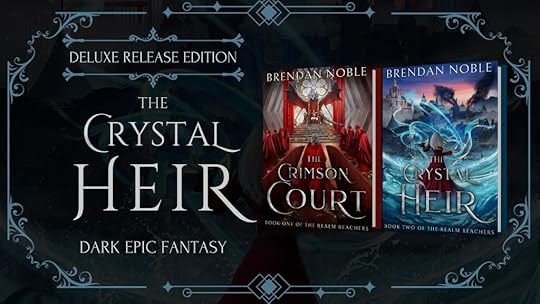
Happy Spring from Nelly and Rebecca – the power of two!
February 14, 2025
Our New Old Journey
Greetings, everyone!
We realize it’s been a while since we’ve posted. It’s not because we haven’t had anything to write about, but because we’ve been super busy working on a new project. Or more accurately, a revamp of an old project.
I have so many ideas running through my head, and when I do, I have to decide what to work on next. What would be the best use of my time to take that idea and make it into a book. This is the hardest part. Which one would make the most appealing story?
Even before I start writing my story, I have to ask questions.
What will my story tell people? Teach them?
In today’s world, we all have short attention spans. We love short, shakable videos and images. Cooking, cute pets, traveling. There are many platforms. Now even AI is getting in on content creation and maybe becoming the future creator of content.
It’s getting more difficult to get people to follow and read content.
Writers ask themselves: How am I going to make someone read 75,000 words and keep them engaged?
Everyone has suggestions and tips and tricks. It’s easy to feel lost in them. I know I feel overwhelmed by them.
Engaging novels need tension…hooks and short chapters… to keep readers hungry and engaged.
Years ago, in 2014, Rebecca and I started our publishing journey by publishing our first book, out first novel called Mystical Emona.
It’s a powerful story of loss, love, and reconciliation. We used beautiful words and descriptions; we embedded Bulgarian rituals, customs, and food. The story takes place in Emona, which to me is like a gateway to Bulgaria, away to learn and explore the country.
At the time, we were novice writers and didn’t fully comprehend the story arc formula. We were part of a critique group and received many—often contradictory—opinions. Some helped, but other hurt the story, and we lost our voice.
We will be forever grateful for everyone’s help, but now we’re beginning a new journey, We’re working on an exciting project, a six-book urban fantasy book series called “Cursed Ring.”
It’s like an alternate reality to Mystical Emona, a powerful story of love, betrayal, and revenge with a strong heroine on a mission to save the world. Every chapter pulls you closer to a truth you might not be ready for… but trust me, you’ll want to and need to know.
We haven’t abandoned the topics we write about in our blog and books. We’ll still include legends, creatures, and mythology that we’ve researched in the series to build a strong and engaging story unique to our style and voice.
Book 1 is complete, and we’re well under way on book 2. We’re working with professional cover designers and editors to make ensure we deliver an enjoyable, inspiring story.
The countdown has begun. Are you ready to face the twists?
KickstarterIf you’d like an early copy of the book before it’s published on retailers, be sure to follow our Kickstarter campaign, launching later this year: https://www.kickstarter.com/projects/ronesa-aveela/cursed-ring-series?ref=5qqb1l.
My soulmate has returned, but is he a bloodthirsty murderer?
Do you love gritty urban fantasy books with a strong female protagonist?Do you enjoy books set in an unusual location?Do you like to emerse youself in tales filled with folklore?Then you’ll be enchanted with Soulmate and Sacrifice, the first book in the DESTINED SOULS: CURSED RING six-book series.

I’ve waited for Dushan for 3,000 years, ever since I watched him take his final breath. But he knows only his new existence as Stefan. I must fight for my soulmate to remember our eternal love before the ring he carries – the one I cursed – causes more innocents to die. Including him.
Worse, evidence points to Stefan being part of a cult responsible for a gruesome ritual murder. I must stop the cult from killing again, even if it means choosing between love and justice. One wrong decision means I’ll have to wait another thousand years for Dushan to return.
April 12, 2024
Journey Home: Exploring Bulgarian Folklore Through My Eyes
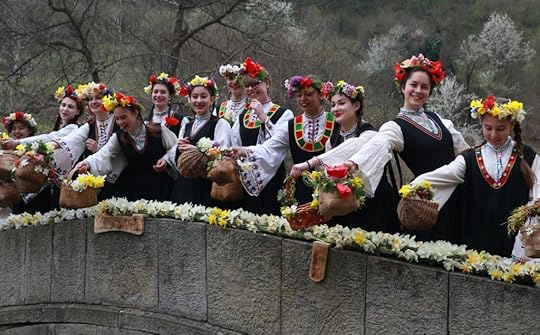
The girls decorate in a colorful and rich way their hairs and go around the village singing songs and dancing, in this way showing they are ready to get married
It’s almost time for our Kickstarter campaign to start. Tuesday, April 16 is launch day for our special edition of our book Light Love Rituals.
This is a special project. Light Love Rituals is more than a book—it’s a piece of my soul, a way to share my upbringing, my experiences, and my love for the rich tapestry of Bulgarian folklore. I believe that each person needs to know their roots and know their identity and culture; otherwise, we are like a tree without roots.
Growing up surrounded by these mysterious traditions, I’ve always felt a deep connection to the land and its stories. In the book I embedded not only information gained from research, but also things I learned and experienced during my life in Bulgaria. I want to keep these memories, cherish them, and pass them not only to my children but to future generations who are born abroad. And through this book, I invite you to experience that connection with me. Discover an ancient culture rich with secrets and legends. Learn more about Bulgarian food and culture. They are colorful and spicy like the souls of the Bulgarian people.
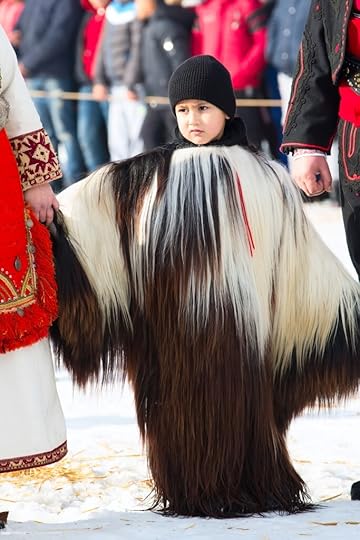
Razlog, Bulgaria – January 14, 2017: Child in traditional carnival kuker costumes at Kukeri festival Starchevata
Join me as we journey through the familiar streets and sounds of my childhood, guided by the incredible artistry of the renowned Keazim Issinov. The book is dedicated to his remarkable art. I was fortune to cross paths with him, and I think this wasn’t a coincidence. We both share a common love for Bulgarian folklore. In his art, he captures the souls of the people, the beauty of the rituals. They are filled with light and love, a harmony of light and love.
Come with me on a journey to the place I call home, the heart of Bulgaria, where every cobblestone holds a story, and every whisper of the wind carries the echo of legends and tales, and where mystical rituals, unknown to the world, weave through the fabric of everyday life. Together, we’ll uncover the beauty of Bulgarian culture, one page and one brushstroke at a time.
Experience the Magic of Home.

Welcome to the picturesque Bulgarian village, where cozy houses line cobblestone streets, nestled closely together with clay roofs gleaming under the sun. As you wander through our charming streets, you’ll be serenaded by the songs of birds, aroma from fresh baked bread and if you lucky you may be able to witness Kukeri and hear the bells or a horo dance at the center of the village.
The book will take you on a folklore journey to Bulgaria from the comfort of your room. Follow our Kickstarter campaign for an enchanting experience unlike any other.
March 29, 2024
Magical Red Easter Eggs
Easter is one of the most holy days in the Christian religion. For the western world, the holiday falls on this coming Sunday, March 31, but the Orthodox will celebrate it on May 5 this year. Bulgarians call the day Velikden, or “Great Day.”
Rituals and beliefs about eggs are prominent on Easter. In particular, red eggs play an important role. For Christians, the red egg symbolizes Christ’s blood, but the egg also has pagan origins. From ancient times, the egg has been a symbol of birth, resurrection, and eternal life—life and death—with a belief that the world was born from the golden egg, that is, the sun. The parts of the egg represent the four elements. The shell is symbolic of earth, the membrane represents air, the liquid is water, and the yellow yoke is the sun and therefore fire.

Eggs are colored during the day on the Thursday before Easter, usually by a female in the household, or, in some cases, only by the oldest woman. Colored eggs are called perashka in some areas of Bulgaria, the word coming from the Slavonic per for “hail” or “thunder.” Thursdays were once believed to be the days to perform rituals to prevent hailstorms. And so dyeing eggs on the Thursday before Easter is said to come from the fact that Thursday was the day of Perun, the god of thunder.
The first egg is always dyed red. This is a special egg that a hen laid that day, or it may be one a black hen laid. After it’s colored, this egg is set by the family’s ikons until the following Easter to bring health and prosperity. The previous year’s egg is buried in fields to protect the crops from hail. Alternately, the egg may be added to sowing seeds to bring a good harvest, or it may even be broken open and used to make predictions based on how it looks.
Red eggs, in general, are believed to have magical and curative powers. Before using the eggs, including the special one, women take all the red eggs outside and lay them on a red cloth to display them to the sun to receive its powers and energy. Afterwards, red eggs are rubbed against the cheeks or foreheads of children, teenage girls, and young brides so they will be as red and healthy as the eggs, and also for beauty and protection from evil spells.
A LegendOne legend describes how the red egg gained this power. An evil wizard once locked up the sun and water in a deep cave using nine padlocks. People and the land suffered for many years. Forgetting their traditions, people fought with one another. One young man lived alone high on a mountain with his young son and daughter, the man’s wife having been forced into servitude by the wizard. The family barely survived the harsh winter.
In spring, while looking for food, the father wanted to give his children a gift. He carved an egg from wood and dyed it red from the soil. By the time he arrived home, his children were asleep, so he placed the egg by their heads. That night, the father received a warning from Father Easter, a white-bearded old man, that the wizard would come for the man’s children the next day. The old man told the father not to fear, but to clench the red egg when the wizard arrived.
As foretold, the wizard came the next morning in a carriage pulled by a three-headed dragon. The father grabbed his children, trying to protect them. As he did so, the egg rolled around and shone like the sun. The father grabbed the egg and lifted it high. Bright light flooded the land, blinding the wizard and transforming him into a black beetle. With the wizard gone, people were able to break the padlocks and release the sun and water, restoring life to the land. Thereafter, people celebrated the rebirth of nature by dyeing eggs red.
KickstarterWould you like to discover more magical rituals and colorful traditions? Embark on a folklore journey to Bulgaria from the comfort of your room. Follow our Kickstarter campaign for an enchanting experience unlike any other. Stay tuned for updates and be ready to immerse yourself in captivating tales of wonder and tradition.
March 8, 2024
The Threads of our Lives: Blessings Encoded within Bulgarian Embroidery (Shevitza)
Kickstarter campaign update:
Our Kickstarter campaign for Light Love Rituals is available now for preview. Please take a look and feel free to give us any feedback before we launch the campaign next month.

Unlike other campaigns, we’re not offering digital rewards besides the ebook. We have permission to use the artist’s illustrations for the book and for promotional purposes, but we cannot share them in other ways. Copies are available, however, from the artist’s son through his Facebook site, so we welcome you to visit there.
Today’s article is about the Bulgarian embroidery, shevitza. You’ll see these symbols throughout our updated copy of Light Love Rituals. We hope this brings more understanding to the importance of these symbols.
~~~
When you look at traditional outfits from different nations, what stands out? If the clothing is Bulgarian, you’re likely to notice the colorful embroidery along necklines, sleeves, and hems. These embellishments are more than merely decorations, however.
Bulgarians perform many customs and rituals to keep people safe from evil forces—whether from spells or spirits. Not least among these protective methods are the more than 800 known shevitzi, the symbols embroidered within their clothing. Some are traditional Slavic designs, while others have been integrated and modified from other cultures over the ages.
SymbolismEach motif serves a purpose, although the meaning of many is now long forgotten or has been changed and re-interpreted by the women who embroidered the symbols. Within the stitches, mothers, mothers-in-law, grandmothers, and great-grandmothers have encoded blessings for health, happiness, longevity, love, abundance, children, prosperity, and spiritual cultivation.
Flowers and plants to this day remain among the most popular symbols, while animals, considered to be among the oldest symbols, are less frequent. Those images that remain are highly stylized, as are images of pests and vermin, which are embroidered into clothing as a means to keep them away. Other motifs may be for tools and common household items.
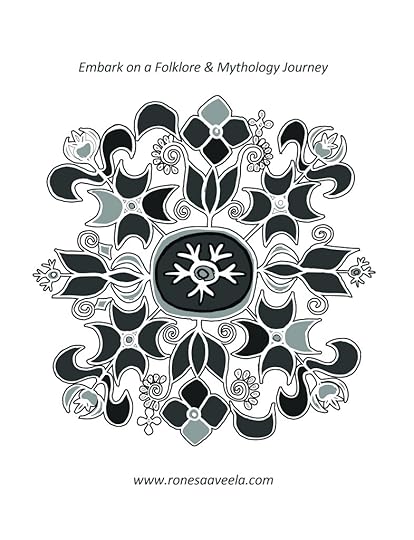
More recognizable motifs are The Tree of Life (reaching into the three realms of heaven, Earth, and underworld), the Mother Goddess (a fertility symbol representing a woman giving birth, who often is shown with horsemen or the sun and moon on either side), the Celestial Turtle (interlocking infinity symbols that represent wisdom, perseverance, and longevity), Elbetica (for the four seasons), and Kanatitsa (three pairs of triangles that represent the cycle of life).
The motif used and its magical meaning can vary depending on what part of the garment they are embroidered on. Some are used on clothing that is worn only on special occasions, while other motifs are strictly only on either men’s or women’s clothing. Designs also indicated a person’s marital status, social class, or where they lived.
The Wedding ShirtShirts have much significance among Bulgarians and are given to people at special occasions, such as weddings, name days, and baptisms. The wedding shirt, in particular, is lavishly ornamented. In the past, it was considered sacred. It was made of linen or hemp because people believed these fabrics held protective power, and linen was associated with the sky. The inability to count the threads in the sleeve was also considered protection against wickedness on Earth, acting as a secure passage to heaven.
Girls began creating their wedding garments around the age of 12. After their wedding, they no longer embroidered their clothing, until the time they taught the craft to their daughters. This wedding shirt was carefully stored until old age as a garment for heaven. It was believed that in paradise, the man and woman would recognize the wedding shirt and so would reunite for eternity.
Embroidered ColorsRed is the predominant embroidery color, with other colors being white, blue, green, yellow, and black or brown. As with the symbols, the colors also have special symbolism.
White and red are the main colors in wedding attire, which symbolize male and female, heaven and earth, connected in a sacred marriage with each other. White is a symbol of the feminine principle, of innocence, purity, and virginity; and red of the masculine principle, of fire and fertility.
Green is the color of nature and new life. It is associated with the Tree of Life.Blue represents the sky, the sea, the water. It embodies truth and trust, purity, serenity and contemplation.Yellow is a symbol of gold and the Sun, a source of joy and merriment, fire, light, as well as the afterlife and the dead.Black or brown is the color of Mother Earth. It embodies stability and security, fertility.The shevitza is colorful and complex like Bulgarian culture itself and symbolizes the soul of the Bulgarian people.
Sources:
Ganeva, Dr. Radoslava. “Bulgarian Folk Costumes – Symbols and Traditions.” Bulgarian Diplomatic Review, Supplement to Issue 3/2003, Year 3. http://www.protobulgarians.com/English%20translations/Bulgarian%20history%20in%20English/Bulgarian%20folk%20costumes%20-%20Symbols%20and%20traditions.pdf.
MacDermott, Mercia. Bulgarian Folk Customs. London and Philadelphia: Jessica Kingsley Publishers, 1998.
Montiglio, Daniel. “The Secret Symbols In The Bulgarian Embroidery.” https://www.foreigner.bg/the-secret-symbols-in-the-bulgarian-embroidery/.
February 2, 2024
Wine Maketh Glad the Heart of Man

Dionysian Feasts by Keazim Issinov
February is the month of wine and roses, with Valentine’s Day celebrated on February 14. This day is also when Bulgarians celebrate Trifonovden, a day focused on vineyards.
Many theories abound about the origins of winemaking. Scholars debate who first brought viticulture to the region of Bulgaria, Greece, and Turkey. Some speculate that when Thracians populated the area, they brought grapevines, cultivated them, and began wine production.
What is less debated is that Trifonovden originated from spring-awakening rituals. Thracian Rozalii performed these rites in forests to celebrate Zagreus, the god of wine and fertility, more popularly known as Dionysus. People commonly associate these celebrations with Maenads, wild woman often depicted in a state of madness, who ripped animals apart and ate them raw.
That’s the god’s dark side.
Violence was not always the case in Dionysian celebrations, however, and a lighter side reflected ideals of life and transformation. One train of thought is that the god’s followers, consumed both wine and drugs to intensify their emotions. These substances transported them from a state of mind concerned with daily matters to one of euphoria. The worshipers danced wildly with others as a way of expressing their ecstasy as they transformed from one state of being to the next.
This continued until they obtained self-forgetfulness. It was only then that the worshippers could identify and unite with Dionysus. In this state they became beings who escaped into the world of nature.
Certain celebrations and rituals may have been performed during special phases of a man’s life. The god was there to ensure the transition from one phase of life to the next was a happy occasion.
Wine, in this situation, has been said to be a metaphor. In order to produce the drink, one must grow and prune the vines to ensure a bountiful crop. After being harvested, the grapes are crushed to release their juices, and finally poured into vats where, with time, they ferment into wine. The fruit must die to become something stronger and perhaps better. All these things reflect the transformation of those who participated in the Dionysian rituals.
Sources:
Henrichs, Albert. “Loss of Self, Suffering, Violence: The Modern View of Dionysus from Nietzsche to Girard.” Harvard Studies in Classical Philology 88 (1984): 205–40. https://doi.org/10.2307/311453.
Isler-Kerényi, Cornelia, and Wilfred G.E. Watson. “DIONYSOS IN ARCHAIC GREEK ART: A SUMMARY.” In Dionysos in Archaic Greece: An Understanding through Images, 209–34. Brill, 2007. http://www.jstor.org/stable/10.1163/j.ctt1w76w9x.12.
KIckstarter Campaign and Free SampleLight Love Rituals has been edited and we’re currently doing the layout work on it. We have the first chapter ready, and you can download a FREE sample here to see more about the information the book contains. We’d love for you to follow our campaign so you know when it goes live.
December 1, 2023
What’s in a Name? Honoring St. Nick
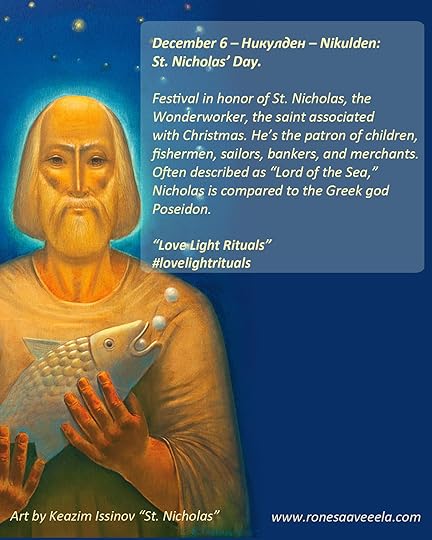
December 6 is Nikulden, a festival in honor of St. Nicholas, the Wonderworker, the saint associated with Christmas. He’s the patron of children, fishermen, sailors, bankers, and merchants. He’s also considered to be in charge of controlling all water bodies and reigns over creatures living in them. Often described as “Lord of the Sea,” Nicholas is compared to the Greek god Poseidon. Born 280 A.D. Died Dec. 6, 343 A.D.
Nikulden is a favorite saint’s feast day for many Bulgarians. He has various names in different parts of the world. Whether you know him as Father Christmas, St. Nick, or Santa Claus, his reputation for giving gifts makes him popular. Children leave stockings for him to fill on Christmas Eve. In Bulgaria, as well as in German-speaking countries, on the eve of December 5, children place wooden shoes by the fireplace, hoping the saint fills them with sweets, gifts, and coins.
The most famous story about the saint’s generosity tells how he secretly threw three purses of gold coins through the window of a poor man’s house for his three unmarried daughters. In those days, women needed a dowry to marry. Without marriage, a woman’s life was even more harsh.
In some parts of Bulgaria, unmarried women leave gifts at the saint’s icon in the church as part of pre-marriage rituals. Another custom is that those who have lost someone to the sea make wreaths, and toss them into the water in the departed’s memory.
Associated with these saint festivals comes the concept of name days, which is sometimes called a “half birthday.” The festivity is like a birthday, but more popular. Instead of celebrating the day of a person’s birth, people celebrate a day associated with that person’s name. Most often, these are held on saint feast days. So, a person named Nicholas would celebrate his name day on December 6. This is also Nelly’s name day, so please stop by wherever you find her on social media and wish her a happy name day!
Those celebrating name days most often provide food and beverages for guests. Since everyone knows when it’s another person’s name day, no special invitations are needed. Anyone can drop by to wish the person a blessing and happiness on his special day. Visitors bring a small gift; in olden days, a common gift was a shirt, a bottle of wine, or an apron.
At one time, if people didn’t want visitors on their name day, they placed ads in the paper stating they wouldn’t be receiving guests.
~ Origins ~Long ago, a person’s name was like a magic word, an amulet, or a spell. Knowing someone’s name gave you power over him. Many fantasy novels work this fact into their storylines.
Even today, Bulgarians consider a person’s name important. One proverb says, “The name makes the man,” while another states, “A man with no name is no man.” On a person’s name day, it is customary to greet him with “Long live you and your name.”
Name days may have come about because people in ancient times didn’t know the exact date of their birth. They’d mention the day of their birth as “born after St. Demetrius’ Day,” “at threshing time,” “before grape-picking,” or “on Holy Virgin’s Day.”
People often named their children after saints, believing the saint would protect and bless the child. Over time, people associated the celebration of the saint’s feast day more with their name than with the saint.
KickstarterAs Nelly and I gear up for our next Kickstarter campaign for a special edition of our book Light Love Rituals, we’ll be posting about Bulgarian rituals and customs. The book takes you through the calendar year, detailing 17 popular holidays. You’ll discover how the days are celebrated, their origins, plus a walk through the holiday with a fictional family. Included in the book are children’s activities, quizzes, fun facts, and a dozen of Nelly’s own tasty recipes to try.
This special edition of the book, which will launch April 16, 2024, is in celebration of the ten years Nelly and I will have been publishing books together. The content will be expanded from the version that’s already published and won’t be available in any of the major retail stores. We’re also making the book extra special by adding gold foil to the cover and sprayed edges. A true collectible book. Well-known Bulgarian artist, Keazim Issinov’s paintings will be used to illustrate the holidays as well as the cover. We’re planning other special rewards as well.
Please follow our campaign to get updated the moment we go live:
https://www.kickstarter.com/projects/ronesa-aveela/light-love-rituals?ref=4tofit
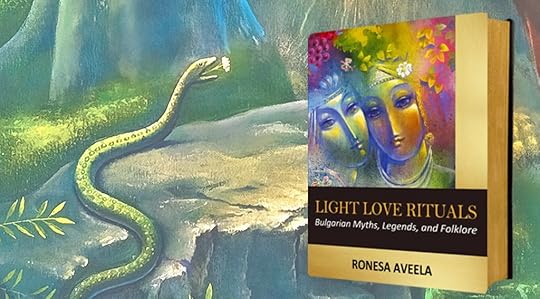
November 10, 2023
Treacheries in the Water – the Tragic Rusalki
If you type the word русалка (rusalka, plural rusalki) into a translation program, it will spit back “mermaid.” That is how westerners think about these water maidens. However, although they have characteristics of mermaids, rusalki lack one essential feature—fish tails (although more modern descriptions, ours included, may portray them this way).
The name “rusalka” may be derived from an old Slavonic word rus (river or stream), ruslo (river bed), or even rosa (dew). Others have thought it comes from the word rusyj/rusaja (strawberry blond, golden [of hair]). Many scholars, however, believe the name of the spirits comes from the spring rusalia festival. Although the rusalia festivals have been mentioned between the twelfth and eighteenth centuries, the term “rusalka” is more recent, first appearing in the eighteenth century.
In ancient societies, people worshipped nature, especially water, and the spirits who lived there—but water spirits were also the most feared of those that roamed the community. Water spirits, who lived the farthest away from the homestead, were the most dangerous and cruelest among their brethren. They lured people into the water with the sole intent of causing them harm. The community never considered drownings to be accidents. Everyone who drowned was a victim of these spirits, who had dragged the unfortunate person beneath the surface.
Although some nature spirits with a connection to water caused death, others also brought life. Among these are the collective beregini fertility spirits and one-time Great Mother earth goddess called Berehynia, who embodied female empowerment. Some believe beregini are the ancestors of rusalki, since these spirits brought moisture to the land. Their name possibly comes from bereghy (“riverbanks” or “shore”).
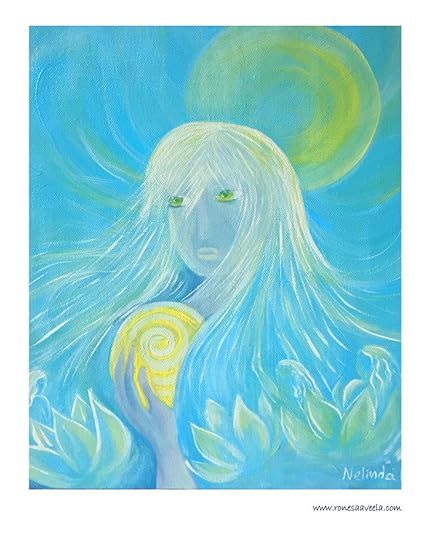
In time, however, these spirits were vilified, and the rusalki were considered demons or the “unclean dead.”
They are women or girls who died during a liminal (that is, in between or transitional) phase of their life: before baptism, on the verge of marriage, or while giving birth. Those who died unclean did not receive proper Christian burial rites as the deceased were considered cursed. These bad deaths deprived the community of the female’s potential fertility, and as such went against society’s social order and moral code (to produce offspring). By dying, she failed in her societal role and therefore wasted her reproductive resources.
The rusalki are the spirits of young women. Not just any young women, but those who have passed from this world in a traumatic way. Specifically, rusalki are the spirits of those who have died in or near water or committed suicide by drowning, especially if it was a result of being spurned by a lover. A few sources claim that any women who don’t marry can become rusalki when they die, because they’re shirking their duty of being wives and mothers. Even married women who drown themselves because of unhappy marriages have the potential to become rusalki
Rusalki wander around the place where they died, moaning about their untimely fate, and they haunt deceitful lovers and seek revenge, unable to find peace until they are avenged. These water maidens love to sit on tree branches, especially willow and birch. From there, they call out men’s names, trying to entice the males to come closer. Those who dare find themselves surrounded by the rusalki who tickle the men to death. Swimming can be fatal to men as well. They become entangled in the rusalki’s long hair and the maidens drag the men to the depths with their iron grips.
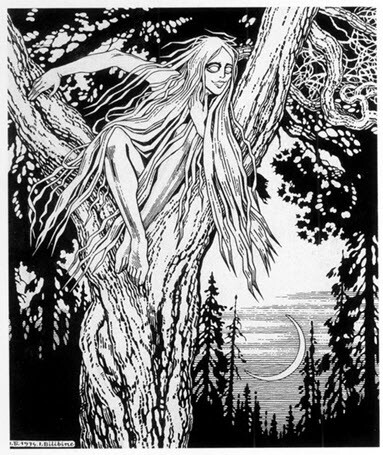
In death, however, as rusalki, the women also have the opportunity to bestow their fertility upon the land. When they brush their thick green hair, water flows and nourishes the land. Also, their voices, when not used to seduce men, sing in eternal harmony and bestow life upon the land. Not only their voices, but rusalki’s mere touch brings nurturing power to growing crops. But they do more than touch. They frolic among the rye, corn, and wheat fields, hanging off the stalks, making them sway as if tossed about by a strong breeze. Even more than their touch, rusalki’s dancing stimulates the soil.
The spirits remain in this undead state, unable to move to the other side, until various conditions are met: 1) they live out what would have been their normal lifespan if they hadn’t had a violent death or committed suicide, 2) they are avenged of their jilted lover, 3) they become human again through the miracle of the cross and baptism, or 4) until Christ returns to the world (what’s commonly called “the second coming”).
If you’d like to learn more about rusalki, check out our book about them, A Study of Rusalki – Slavic Mermaids of Eastern Europe.
October 13, 2023
Don’t Go Near the Water (Bull)
The Water Bull has been described as a Bulgarian Loch Ness monster. Except, I don’t think any folktales exist the Nessie was tamed by love, not that Nessie is considered a vicious monster to start with. The similarities between the two creatures exist in the fact that both make their homes in deep bodies of water. While Nessie is in Scotland, the Water Bull’s home is in Rabisha Lake in the Belogradchik municipality, in northwestern Bulgaria. This lake, at 1.25 square miles with a depth of 49 feet, is Bulgaria’s largest interior lake, having plenty of room for the monster to hide away.
He’s a frightening creature, a massive-sized being with the head of a bull, body of a man, and tail of a fish. He sports erect horns that point straight ahead. Those people who have seen him, describe him as “naked without hair” or “without skin.” Accounts vary on his coloring: it may be black, gray, or red. Other people are steadfast that the creature is invisible. You can tell he is around because he roars like a beast and stirs the water in which he lives.
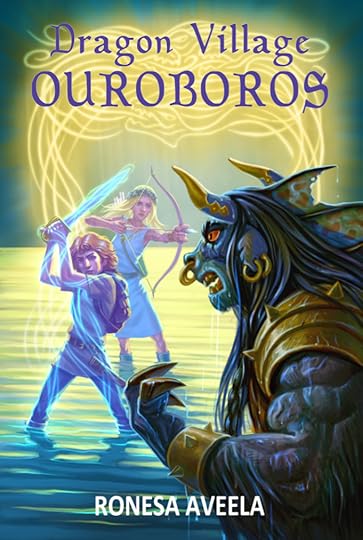 Water Bull. Cover of book 3 in the Dragon Village series. Image by Alexander Petkov.
Water Bull. Cover of book 3 in the Dragon Village series. Image by Alexander Petkov.As you can imagine, he is an otherworldly creature. The fact that he lives in the depths of the water makes him a chthonic being. He is the sabiya, the lord and owner, of that water body. As the sabiya, he has been perceived as dead, a zoomorphic ancestor, even a deceased shaman. In this role, he has the power to both protect and punish. The water itself is at his command. With it, he brings life and fertility. According to one legend, every spring, the sabiya turned the water in a certain spring a pale red from a blood sacrifice he made. But he is also destructive and can cause the water to flood the land and bring death, or make the water disappear entirely.
Besides causing flooding, the Water Bull inflicts other damage to villagers. Or, more specifically, their cattle. First, he attacked oxen, especially any that ventured close to the water, and he caused pestilence among the cattle. Second, he mated with the females. The calves they birthed were sickly animals and “half naked.” They could live neither on land nor in the water and soon died.
Both of these types of actions, flooding and injury to cattle, were threats to the survival of humankind. And so, as people advanced with the knowledge of metals and forging iron and with the growth of agriculture, however, the Water Bull lost his prized position as sabiya. This chthonic being was no longer a master. All that was good about him was transferred to a celestial deity, the god of lightning and thunder. The Water Bull has become a creature that needs to be destroyed. The chthonic being must be exiled while the celestial one becomes exalted.
He can be defeated in the ways all demonic creatures can – by iron. For this reason, villagers put iron on the tips of their bull’s horns to it could fight the Water Bull when it ventured from the water to devour one of the oxen. Animal must battle animal.
When the water became bloodied, it was proof the Water Bull had been defeated, although perhaps not killed. This had an adverse effect, however. The water source would dry up and appear in another location, often even in another village. The defeated Water Bull took it with him to a new, and – he hoped – friendlier location. Some said the water had been tamed, and would no longer be ruled by the Water Bull. In another instance after the water source had dried up for ten years, villagers wanted to move away. Finally, the one who had slain the Water Bull offered a kurban, a sacrificial animal, to restore the flow of water.
What Does This Mean?These types of occurrences have been described as people explaining the reality of nature through a folkloric means. Since water is essential for human existence, it is considered sacred. The creatures that inhabit it must be reverenced and worshiped. Sacrifices must be offered to ensure these beings are appeased. Otherwise, the water creatures will take offense and create havoc. In the case of the Water Bull, he will kill cattle, cause flooding and cattle pestilence. As a way to prevent the cattle from being harmed, people would prohibit livestock from grazing too closely to the water. In this way, water would have a better chance of not being defiled by animal waste.
A Different Kind of Dragon?The Water Bull and dragons may seem to be completely different beasts, yet still, in folklore, they have similarities. Did you know that in some stories, they function in like manners? Slay the beast or drive it away to protect the living. The well-known tale of St. George slaying the dragon is one such story.
I found an interesting look about this in a post from Old European Culture (http://oldeuropeanculture.blogspot.com/2019/03/water-bull.html).
The fact that the “monster” to whom the young girls were sacrificed was identified as both dragon and bull is very interesting. Dragon represents the destructive power of the burning summer sun. And summer starts in Taurus (Bull).
Summer starts on the 6th of May, Jarilo day, Beltine (middle of Taurus). Jarilo represents the sun’s heat, symbolized by the snake and the dragon. Funnily Jarilo was Christianized into St George, the Dragon killer, who kills Dragon-Bull.
On occasion, villager accounts also compared the Water Bull to the male dragon, the zmey, who loved human girls and desired to kidnap them for his bride. People in one village tell a tale of a zmey who came out of the water he lived in. Like other zmeys, this one could appear as a young man. The way to tell the difference was the small wings below his armpits. One time this zmey came out and a girl’s father or brother was there to greet him with a rifle. The dragon was shot and tossed back into the water. The water turned red with his blood and disappeared.
One major difference here is that the Water Bull harms animals, while the dragon has malicious intents toward humankind. If he doesn’t get what he wants, he can cause droughts. Similarly, the lamia, a three-headed female dragon, is often said to control the waters and is known for drying up the water. She requires human sacrifices in order to keep the water flowing.
We talk more about the roles of dragons in our book A Study of Dragons of Eastern Europe.
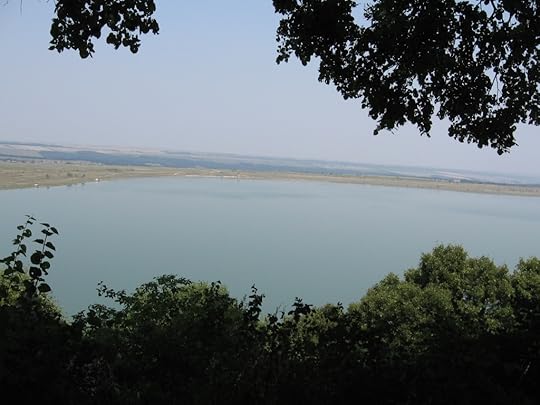 Rabisha Lake. Public domain, via Wikimedia Commons.The Legend
Rabisha Lake. Public domain, via Wikimedia Commons.The LegendNow, how was the Water Bull tamed by love? A tale from the eighteenth century tells how a Water Bull terrorized villagers living around Rabisha Lake. Every year, the most beautiful girl from the area was offered as a sacrifice to the beast. She was paraded from the village to the water’s edge, where she was put on a boat, along with other gifts, as an offering to the monster. She was never seen again.
One year, however, the girl to be sacrificed held beauty far beyond any of those who had been offered to the beast before. When the boat she was on reached the middle of the lake, the Water Bull arose, ready to devour his prey. However, one look at her and he became enchanted. He had no desire to consume her. Rather, he was consumed by her beauty.
With love burning in his heart, he beseeched his sister, who was a sorceress, to find a way to make the girl immortal, so she could live beneath the water with him. His sister complied, and the Water Bull descended to the bottom of the lake with his beloved bride. No more did he demand sacrifices. He and his love are said to still live happily within the depths of Rabisha Lake.
October 6, 2023
Tangled in Thorns – Ispolini, Giants of Old
In folklore, the Ispolini were a race of people the gods created after the Dzhudzheta, the little people or dwarves. They died out because their slight height prevented them from being able to protect themselves from wild animals. They also found themselves inept at cultivating the land.
Then the gods corrected this problem and created a towering species, the Ispolini. They rose about the land to a height of up to 3 meters (9.8 feet). Not only were they tall, but they possessed huge heads and sometimes three. Each had only a single eye. Some tales described them as having only one leg.
In some Slavic lands, people believed the wind could waft the soul of a sleeping man to mountain summits. When enough of them had been gathered, they merged and became giants. Animal spirits, particularly oxen, could also form part of this monstrous being. During spring and autumn, they actively uprooted trees to use as clubs and hurled rocks at one another.
Their domain was caves in mountainous regions. Their voices rang out from one mountaintop to another. Unlike the Dzhudzheta, the Ispolini did not till the land. They survived on raw meat, perhaps even that of dragons, who were their natural enemies.
A Serbian giant, Balachko, possessed three heads. One could breathe fire, while the others blasted out icy cold wind. To defeat the giant, one had to wait until he exhausted himself and the fire and icy winds ceased. Thus vulnerable, the epic hero, Miloš Vojinović, could defeat the monster.
The gods congratulated themselves. Here was a race that could survive in the world. But, alas, the deities patted themselves on the back too soon. For the Ispolini, too, had a fatal weakness. They easily got entangled in blackberry bushes. Unable to free themselves from the thorns, they stumbled, broke bones, and eventually the giants began to die.
Once more, the deities allowed this species to die out. They did they by giving animals the ability to hide or conceal themselves from their main predator, the Ispolini. Thus, the little people died out because they could not till the land, and the tall people because they could not hunt.
Their third attempt was humankind, of a height between the small people and the tall people. And I’ll let you be the judge whether or not the third time was a charm.
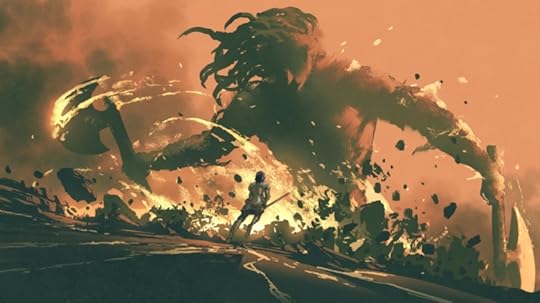 Image licensed from Depositphotos.Ancestral Giants
Image licensed from Depositphotos.Ancestral GiantsBut there is more to these giants than what folklore tells. Among the Thracians, the giants were considered ancestors. As the giant race died out and the human one began, the races interbred, creating the heroes of old, like Krali Marko, Sviatogor, and Ilya Muromets. The Proto-Bulgarian epics describe them as having divine blood mixed in with their human bloodlines. This does not necessarily make them good. They tend to be both infinitely good and terribly bad.
The name Ispolini is thought to be derived from spali. These refers to defeated Goths living in southern Russia. In the Strandja Mountains, there’s a place called the “Propada” graveyard, a necropolis where more than 100 tombs have been discovered. Those buried there were miners. The graves of those found lower on the hill are cheaper and smaller burial plots, probably of the common people. Higher up, the tombs become more elaborate, and at the peak is found a tomb that likely belonged to a wealthy landowner.
However, a tomb found near a family plot deserves more attention. It belonged to a man with fiery red hair and who was over 2 meters tall, much taller than any of the others found. It’s estimated the person lived around 100 or 200 BC. Nearby is a tomb believed to belong to his wife, who are normal height. It’s believed that the tall person was not local and was likely a Goth, a race that was attacking the empire at that time.
Another thought is that these giants came from a Thracian warrior tribe, Peons, who were allies of Troy. Dozens of skeletons of men of giant stature have found near the village of Pastouch, Bulgaria, where this tribe lived. The giant skull of a child is believed to be contained within a chest inside the Holy Trinity chapel there.
Although legends say they were 3 meters tall, graves found indicate these foreigners were closer to 2 meters (6.6 feet). To the people of the day, who rarely exceeded five feet tall, anyone that height would be considered a giant.
Kickstarter CampaignWon’t you join us before October 12 to visit the land of Zmeykovo, Dragon Village, where you can meet this mighty giants from the past?

Dangers lurk in Dragon Village, but also secrets. Can Theo solve the mysteries before an evil creature conquers the magical and human worlds?
Do you have an adventurous soul, ready to encounter strange magical creatures?Have you ever wished you could travel through a portal to another world?Do you love the reluctant hero, strong female friends, and quirky sidekicks?If this sounds like you, then step through the gate into the magical world of Dragon Village.
Campaign link: https://www.kickstarter.com/projects/ronesa-aveela/dragon-village?ref=3i92sy

